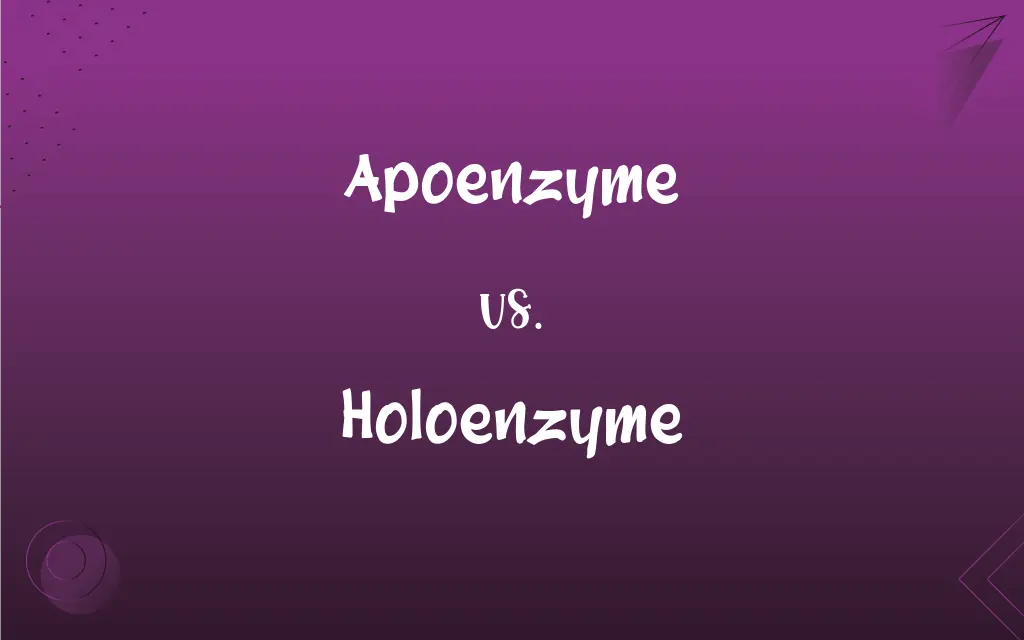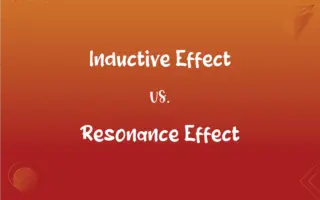Apoenzyme vs. Holoenzyme: What's the Difference?
Edited by Aimie Carlson || By Harlon Moss || Published on January 15, 2024
An apoenzyme is the protein component of an enzyme, inactive on its own, while a holoenzyme is the complete, active enzyme formed when an apoenzyme binds with its cofactor.

Key Differences
An apoenzyme refers to the protein part of an enzyme, inherently inactive until it combines with a non-protein component. In contrast, a holoenzyme is the fully active form of an enzyme, consisting of the apoenzyme and its necessary cofactor.
The apoenzyme alone is incapable of catalyzing a reaction as it lacks the essential non-protein component, usually a cofactor or coenzyme. The holoenzyme, on the other hand, is catalytically active, as the cofactor completes its structure and functional capacity.
Apoenzymes require the binding of a cofactor to achieve the correct three-dimensional structure for activity. Holoenzymes represent the structurally and functionally complete unit, able to engage in and accelerate specific biochemical reactions.
The relationship between an apoenzyme and its cofactor is highly specific; not every cofactor can activate every apoenzyme. This specificity is crucial in the holoenzyme's ability to catalyze particular reactions, ensuring precise biochemical pathways.
In biological systems, the conversion of an apoenzyme to a holoenzyme is a critical regulatory mechanism, controlling enzyme activity. Understanding the structure and function of holoenzymes is essential in many fields, including pharmacology and biochemistry, where enzyme modulation is key.
ADVERTISEMENT
Comparison Chart
Definition
Protein component of an enzyme, inactive alone
Complete and active enzyme with its cofactor
Activity
Inactive without cofactor
Active and functional
Composition
Only the protein part
Protein part plus cofactor (metal ion or coenzyme)
Role in Catalysis
Cannot catalyze reactions independently
Can catalyze specific biochemical reactions
Biological Significance
Needs cofactor for activation
Fully operational in biochemical pathways
ADVERTISEMENT
Apoenzyme and Holoenzyme Definitions
Apoenzyme
An apoenzyme is the inactive protein part of an enzyme.
The apoenzyme requires a cofactor to become catalytically active.
Holoenzyme
A holoenzyme is a complete and active enzyme with its cofactor.
The holoenzyme was fully functional in catalyzing the reaction.
Apoenzyme
Apoenzyme is the protein component of a holoenzyme, lacking a cofactor.
In the absence of its cofactor, the apoenzyme remains dormant.
Holoenzyme
Holoenzyme is the combination of an apoenzyme and its necessary cofactor.
The study revealed how the holoenzyme plays a role in metabolism.
Apoenzyme
An apoenzyme is an enzyme's structure minus its non-protein part.
The study focused on the 3D structure of the apoenzyme.
Holoenzyme
A holoenzyme is the active form of an enzyme, ready for catalysis.
In the liver, the holoenzyme facilitates crucial biochemical processes.
Apoenzyme
Apoenzyme forms part of the holoenzyme, needing a cofactor to function.
Binding of the cofactor to the apoenzyme triggers enzymatic activity.
Holoenzyme
Holoenzyme refers to an enzyme's operational structure in biological systems.
Scientists are exploring ways to inhibit specific holoenzymes in disease treatment.
Apoenzyme
An apoenzyme is the incomplete form of an enzyme.
Researchers examined how the apoenzyme interacts with potential cofactors.
Holoenzyme
A holoenzyme is a biochemically complete enzyme unit.
The effectiveness of the holoenzyme depends on the integrity of its cofactor.
Apoenzyme
The protein component of an enzyme, excluding additional components such as cofactors or inhibitors.
Holoenzyme
An active, complex enzyme consisting of an apoenzyme and a coenzyme.
Apoenzyme
(enzyme) An inactive haloenzyme lacking a cofactor.
Holoenzyme
(enzyme) A haloenzyme.
Apoenzyme
A protein that combines with a coenzyme to form an active enzyme
FAQs
What is a holoenzyme?
A holoenzyme is the complete, active enzyme formed when an apoenzyme binds with its cofactor.
Is an apoenzyme catalytically active?
No, an apoenzyme alone is not catalytically active.
What is an apoenzyme?
An apoenzyme is the protein component of an enzyme, inactive on its own.
Can an apoenzyme function without a cofactor?
No, an apoenzyme requires a cofactor to become active.
What makes up a holoenzyme?
A holoenzyme consists of an apoenzyme and its associated cofactor.
Can any cofactor bind to any apoenzyme?
No, the binding between an apoenzyme and a cofactor is highly specific.
What is the role of a holoenzyme?
A holoenzyme catalyzes specific biochemical reactions.
Can an apoenzyme have multiple cofactors?
Yes, some apoenzymes require multiple cofactors to become active holoenzymes.
What is the importance of studying holoenzymes?
Studying holoenzymes is crucial for understanding enzyme mechanisms and drug development.
What types of cofactors are there for holoenzymes?
Cofactors can be metal ions or organic molecules like coenzymes.
Are apoenzymes functional in cells?
Apoenzymes are not functional in cells until they bind with the appropriate cofactor.
What is the clinical significance of holoenzymes?
Holoenzymes are significant in clinical research for understanding diseases and developing treatments.
How do cofactors affect the structure of apoenzymes?
Cofactors induce conformational changes in apoenzymes, enabling them to attain a functional structure.
How does an apoenzyme become a holoenzyme?
An apoenzyme becomes a holoenzyme upon binding with its cofactor.
How is enzyme activity regulated through apoenzymes?
Enzyme activity is regulated by the availability and binding of cofactors to apoenzymes.
Do all enzymes have an apoenzyme and holoenzyme form?
Most enzymes exist as apoenzymes and become holoenzymes, but some exceptions exist.
How are apoenzymes studied in the lab?
Apoenzymes are studied through biochemical and structural analysis to understand their function and interaction with cofactors.
What happens if a cofactor is missing from a holoenzyme?
Without its cofactor, a holoenzyme reverts to an inactive apoenzyme state.
Can holoenzymes be inhibited?
Yes, holoenzymes can be inhibited by specific inhibitors, affecting the enzyme's function.
Can the apoenzyme-holoenzyme conversion be reversible?
Yes, the conversion between apoenzyme and holoenzyme is typically reversible.
About Author
Written by
Harlon MossHarlon is a seasoned quality moderator and accomplished content writer for Difference Wiki. An alumnus of the prestigious University of California, he earned his degree in Computer Science. Leveraging his academic background, Harlon brings a meticulous and informed perspective to his work, ensuring content accuracy and excellence.
Edited by
Aimie CarlsonAimie Carlson, holding a master's degree in English literature, is a fervent English language enthusiast. She lends her writing talents to Difference Wiki, a prominent website that specializes in comparisons, offering readers insightful analyses that both captivate and inform.






































































